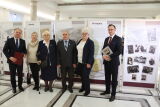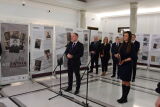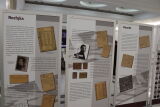back...Opening ceremony of the exhibition titled ‘An Extraodrinary Polish Family. The fate of Gertruda Nowak – a child from the Camp on Przemysłowa Street’
In connection with the celebration of the 80th anniversary of the launch of the Nazi German concentration camp for Polish children on Przemysłowa Street in Łódź, the opening of an exhibition titled ‘Niezwykła polska rodzina. Losy Gertrudy Nowak - dziecka z obozu na Przemysłowej’ took place at the Polish Parliament in the Sejm on December 1. It refers to a recent publication issued by the Museum of Polish Children – victims of totalitarianism. The exhibition was funded by Polska Grupa Energetyczna.
The exhibition titled ‘Niezwykła polska rodzina. Losy Gertrudy Nowak - dziecka z obozu na Przemysłowej’ was prepared by the Museum of Polish Children – victims of totalitarianism. It is based on unique archival materials included in the only personal file so completely preserved, documenting the imprisonment and dramatic camp experiences of a girl brutally separated from her parents and sisters and incarcerated with her brothers in the German concentration camp for Polish children on Przemysłowa Street in Łódź.
Many of the hundreds of thousands of the Kowalskis, the Nowaks or the Wiśniewskis went through the hell of German and Soviet prisons, torture houses, camps. Polish families, uprooted by the brutal force of the occupiers from the eternal trail of life, faced situations requiring extraordinary courage, sacrifice and will to survive. The married couple of Sylwester and Julianna Nowak led a quiet life in the suburban village of Mosina. They had five children – three daughters: Aniela, Alicia and Gertruda and two sons: Jerzy and Edward.
After the outbreak of World War II, the Nowaks’ home village became part of the Reichsgau Wartheland, a newly created district of the German Reich. Sylwester had already joined the Polish independence underground since 1939. He joined the ‘Dla Ciebie Polsko’ [For You Poland] movement. In 1942, a wave of arrests hit members of the Union of Retaliation in the Poznań District of the Union of Armed Struggle – Home Army, led by dr Franciszek Witaszek. A group of ‘Witaszkowcy’ [Witaszek supporters] was accused of carrying out attacks targeting collaborators and German officers with poisons. Members of the unit, including dr Witaszek himself, were sentenced to death. In January 1943, they were executed at Fort VII in Poznań.
The repression spread to wider and wider circles. Once set in motion, however, the German terror machine could not stop there. In late 1942 and early 1943, arrests began among Mosina residents. They also reached Sylwester Nowak. Early March 1943, he was arrested and imprisoned in Fort VII. The imprisoned father maintained contact by letter with his wife and children who remained at large. Along with the correspondence, testimony of the ruthless treatment to which Sylvester was subjected arrived at the Nowaks’ home. When delivering packages and exchanging his prison underwear for clean ones, Julianna picked up her husband’s bloodstained clothes. Finally, on August 1, 1943, Sylwester Nowak was deported from Fort VII in an unknown direction. He was most likely executed then.
On September 9, 1943, Julianna and her four children Aniela, Alicia, Jerzy and Edward arrested. The mother and both daughters were incarcerated in the Żabikowo camp. The boys were transported to a completely different location. They were soon joined by their sister Gertruda.
On December 1, 1942, in an area separated from the Łódź ghetto, the German occupation authorities launched a camp unlike any other. It was intended exclusively for Polish children. The original name of this unique execution site was Polen-Jugendverwahrlager der Sicherheitspolizei in Litzmannstadt, and we could translate it as Supervisory Camp for Young Poles of the Security Police in Litzmannstadt, but as with many other terms used by the Third Reich authorities, such a procedure would not serve to reveal the reality hidden behind the name. In fact, it was a concentration camp designed to slowly destroy the children imprisoned there, and for some of them it became a place of death. From the name of the street where the main gate of the Polen-Jugendverwahrlager was located, it took its colloquial name of ‘the camp on Przemysłowa Street’.
The compilation of the documentation presented at the exhibition would not have been possible had it not been for the courage and prudence of Gertruda Nowak who, overcoming her fear, saved her personal file folder and a multitude of photographs of small prisoners. Thanks to this act of courage, we can discover her family’s unique story and look at the faces of other children from Przemysłowa Street.
The ceremony was attended by: Małgorzata Gosiewska, Deputy Speaker of the Sejm; prof. dr hab. Piotr Gliński, Deputy Prime Minister, Minister of Culture and National Heritage; Mikołaj Pawlak, Ombudsman for Children; Wojciech Dąbrowski, President of the Management Board of PGE Polska Grupa Energetyczna; dr Ireneusz Maj, director of the Museum of Polish Children – victims of totalitarianism; representatives of Survivors: Joanna Piotrowska, Henryka Kowalska-Śliwicka and Jerzy Jeżewicz; the daughter of former camp inmate Gertruda Nowak – Alicja Hetmańska; and dr Andrzej Janicki, Museum historian and curator of the exhibition.
The task was carried out thanks to funds provided by PGE Polska Grupa Energetyczna S.A.





